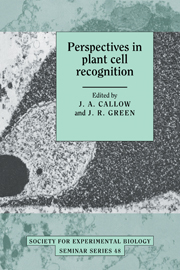Book contents
- Frontmatter
- Contents
- List of contributors
- Preface
- Sexual signalling in Chlamydomonas
- Gamete recognition and fertilisation in the fucoid algae
- The fungal surface and its role in sexual interactions
- Gamete recognition in angiosperms: model and strategy for analysis
- The molecular biology of self-incompatible responses
- Cell surface arabinogalactan proteins, arabinogalactans and plant development
- Local and systemic signalling during a plant defence response
- Contact sensing during infection by fungal pathogens
- The electrophysiology of root–zoospore interactions
- Molecular differentiation and development of the host–parasite interface in powdery mildew of pea
- Recognition signals and initiation of host responses controlling basic incompatibility between fungi and plants
- Cell surface interactions in endomycorrhizal symbiosis
- Host recognition in the Rhizobium leguminosarum–pea symbiosis
- The Rhizobium trap: root hair curling in root–nodule symbiosis
- Structure and function of Rhizobium lipopolysaccharide in relation to legume nodule development
- Index
- Plate section
The Rhizobium trap: root hair curling in root–nodule symbiosis
Published online by Cambridge University Press: 07 May 2010
- Frontmatter
- Contents
- List of contributors
- Preface
- Sexual signalling in Chlamydomonas
- Gamete recognition and fertilisation in the fucoid algae
- The fungal surface and its role in sexual interactions
- Gamete recognition in angiosperms: model and strategy for analysis
- The molecular biology of self-incompatible responses
- Cell surface arabinogalactan proteins, arabinogalactans and plant development
- Local and systemic signalling during a plant defence response
- Contact sensing during infection by fungal pathogens
- The electrophysiology of root–zoospore interactions
- Molecular differentiation and development of the host–parasite interface in powdery mildew of pea
- Recognition signals and initiation of host responses controlling basic incompatibility between fungi and plants
- Cell surface interactions in endomycorrhizal symbiosis
- Host recognition in the Rhizobium leguminosarum–pea symbiosis
- The Rhizobium trap: root hair curling in root–nodule symbiosis
- Structure and function of Rhizobium lipopolysaccharide in relation to legume nodule development
- Index
- Plate section
Summary
Introduction
The root-nodule bacteria Rhizobium, Bradyrhizobium and Azorhizobium (collectively rhizobia) invade and nodulate the roots of their host plants via either wounds or root hairs. The choice is made by the host plant, e.g. the same rhizobial strain infects Vigna roots via root hairs and Arachis roots via wounds (Sen & Weaver, 1984), whereas another strain infects Parasponia via root epidermal cracks and Macroptilium via root hairs (Marvel et al., 1985). Shortly before or during root invasion, rhizobia induce cell divisions in the root cortex, resulting in formation of a nodule primordium. Through infection threads (tip-growing tubular structures containing invading rhizobia) and/or between cortical cells the rhizobia migrate towards the growing primordium, are endocytosed by young nodule cells, and differentiate into dinitrogenfixing bacteroids (see also Brewin et al., this volume).
Rhizobial invasion of most agronomically important legumes such as pea (Pisum sativum), soybean (Glycine max) and bean (Phaseolus vulgaris) occurs through root hairs. Infection of a living plant cell is an unusual phenomenon in plant–bacteria interactions. Plants are open organisms. At many sites, the intercellular space of a plant is in direct contact with the environment, e.g. in stomata, hydathodes or wounds resulting from emergence of lateral roots. A plant is used to regular visits of (plant-associated) bacteria to its interior. Therefore, wound-infection by rhizobia is a normal phenomenon whereas root hair infection is special.
- Type
- Chapter
- Information
- Perspectives in Plant Cell Recognition , pp. 267 - 284Publisher: Cambridge University PressPrint publication year: 1992
- 3
- Cited by

